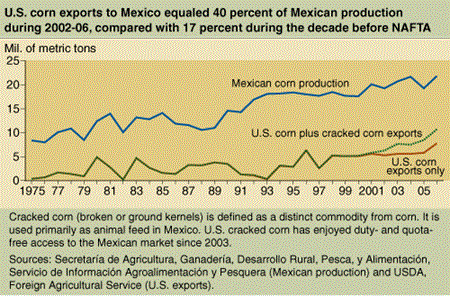NAFTA’s Liberalization of Corn Trade Approaches the Finish Line

Implementation of the North American Free Trade Agreement (NAFTA) is nearly complete. Since the start of the agreement’s implementation in 1994, member countries Canada, Mexico, and the United States have systematically dismantled thousands of restrictions on regional trade. The few trade barriers that remain to be phased out under NAFTA—including the transitional tariff-rate quota (TRQ) for U.S. corn exports to Mexico—will be eliminated in 2008.
Corn is a staple in Mexico, where it is cultivated by producers who range from large commercial operations to farmers with less than 5 hectares (about 12 acres). About 1.5 million of Mexico’s farmers cultivate corn, and many of those with smaller land holdings live in poverty. The TRQ was established with these circumstances in mind, and corn is one of a few commodities whose transition to free trade has taken place over 14 years (1994-2007), the longest transition period allowed by the agreement. This TRQ gradually became less restrictive during the transition and will disappear in 2008. The corn TRQ, along with additional actions taken by Mexico, has allowed substantial growth in trade, and the last step of NAFTA’s implementation is unlikely to generate a large additional impact.
In recent years, the Mexican Government has pursued a more liberal trade policy toward corn than required by NAFTA. Import tariffs of 2 percent or less have often been applied beyond the duty-free amount of the TRQ, rather than the prohibitive over-quota tariff allowed by the agreement. Usually, this special treatment has been reserved for yellow corn, which is used in Mexico mainly to feed livestock and to manufacture starch. As a result, U.S. corn exports to Mexico (including cracked corn, which is not subject to the TRQ) reached 40 percent of Mexican production during 2002-06, compared with 17 percent during 1984-93, the decade preceding NAFTA. Yellow corn makes up the bulk of this trade, while white corn, used mainly to make tortillas, accounts for less than 5 percent.
An important question is how growth of the U.S. ethanol sector will affect Mexico. Increased corn demand from the ethanol industry has led to higher prices and greater competition among corn buyers. In early 2007, tortilla prices in Mexico jumped by roughly 40 percent from their mid-2006 level. Although U.S. ethanol is rarely made from white corn, both white corn and yellow corn are used to feed livestock in Mexico, and this overlap between the two corn markets links ethanol to tortillas.
NAFTA at 13: Implementation Nears Completion, by Steven Zahniser, USDA, Economic Research Service, March 2007
Corn and Other Feed Grains, by Aaron M. Ates, USDA, Economic Research Service, December 2023
USMCA, Canada, & Mexico, by Steven Zahniser, USDA, Economic Research Service, September 2023


